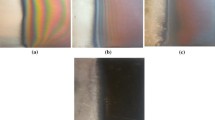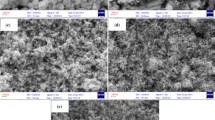Abstract
Electrochemical impedance and cyclic voltammetric measurements of magnetite coating formed on carbon steel substrates were carried out in deaerated solutions of 1.0 × 10−2 M ascorbic acid and 3.5 × 10−2 M picolinic acid at 28 °C. Impedance data showed that the interaction between magnetite and ascorbic acid is associated with an incubation period, after which reductive dissolution takes place accompanied by oxidation of ascorbic acid. Once the magnetite film loses its thickness and protective properties on prolonged exposure to ascorbic acid, the charge transfer resistance and the capacitance is reduced. Initial dissolution of magnetite in picolinic acid is due to congruent chemical dissolution with little contribution from reduction by the electrons arising from the corrosive attack of acid on the carbon steel. With time the contribution of the latter process increases as more and more of the substrate opens up. Cyclic voltammetric studies showed that there is an adsorption phenomenon leading to the formation of a surface ferric complex that undergoes reduction to the ferrous species and transfers to the bulk solution. The accumulation of the ferrous ion accelerates the dissolution resulting in an increase in current. Dissolution of magnetite in picolinic acid is slow. The better complexing capability of picolinic acid compared to ascorbic acid does not permit the accumulation of the ferrous ion as indicated by the absence of a peak in the voltammogram.
Similar content being viewed by others
References
G.R. Srinivasan, NPCIL (1992), (personal communication).
S. Dutta, S. Ramabhadran and R.S. Shetiya, BARC Report, BARC/1993/1/025 (1993).
F. Mansfeld, Electrochim. Acta 35 (1990) 1533.
ChintamaniDas, M. Sudersanan and M.K. Totlani, in A.S. Khanna, K.S. Sharma and A.K. Sinha (Eds), 'Emerging Trends in Corrosion Control: Evaluation, Monitoring, Solution's, Vol 1, (Akademia Books International, New Delhi, 1999), p. 145.
S. Rengamani, S. Murlidharan, M.A. Nathan and S.V. Iyer, J. Appl. Electrochem. 24 (1994) 355.
S. Rengamani, S. Murlidharan, M. Ganesan and S.V. Iyer, Indian J. Chem. Technol. 1 (1994) 168.
K.B. Gaonkar, ‘Studies on Formation and Characterization of Magnetite on Carbon steel in High Temperature Water’, PhD thesis, Mumbai University (1993).
F. Mansfeld, Corrosion 44(8) (1988) 556.
M. Pourbaix, ‘Atlas of Electrochemical Equilibria in Aqueous Solutions’ (Permagon, 1966), p. 307.
W.M. Clark, ‘Oxidation—Reduction Potentials of Organic Systems’, (Robert E. Krieger Publishing, Huntington, New York, 1972).
F. Mansfeld, M.W. Kendig and S. Tsai, Corrosion 38(9) (1982) 478.
I.H. Plonski, Mater Sci. Forum. 185–188 (1995) 649.
A.E. Martell and R.M. Smith, ‘Critical Stability Constants’ (PlenumPress, London, 1974).
P. R. Singh, P.K. Chauhan and H.S. Gadiyar, J. Electrochem. Soc. India 30(4) (1981) 322.
R. Gilbert and L. Ouellet, Nucl. Technol. 68 (1985) 385.
R. Torres, M.A. Blesa and E. Matijevic, J. ColloidInterface. Sci. 134 (475) 1990.
Author information
Authors and Affiliations
Corresponding author
Rights and permissions
About this article
Cite this article
Das, C., Sudersanan, M. Electrochemical studies of magnetite coating on carbon steel in ascorbic and picolinic acid. Journal of Applied Electrochemistry 33, 333–338 (2003). https://doi.org/10.1023/A:1024187216639
Issue Date:
DOI: https://doi.org/10.1023/A:1024187216639




